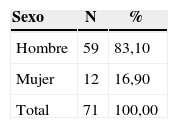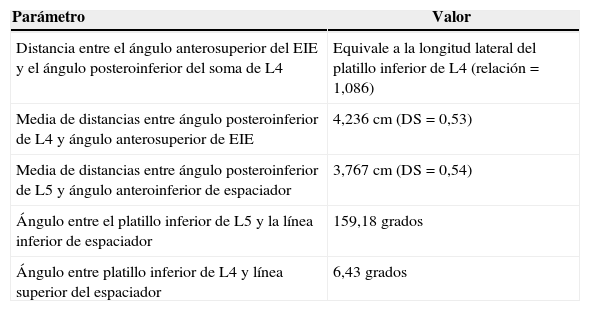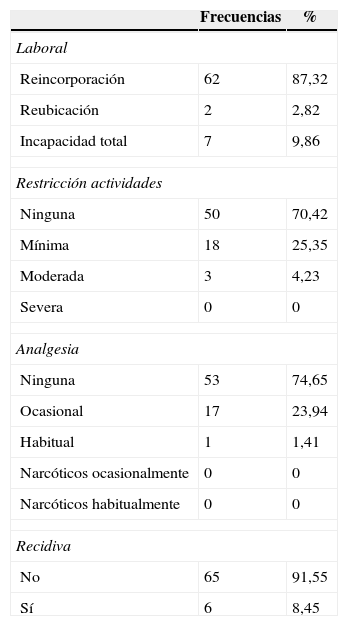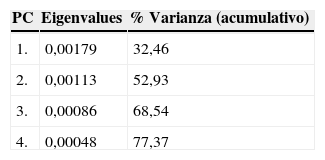Una indicación controvertida de los espaciadores interespinosos es su utilización complementaria a la discectomía. Actualmente, no existen evidencias sólidas de la eficacia de dicha asociación, lo que podría derivar de la variabilidad en la colocación del espaciador, limitando su labor biomecánica. El presente trabajo busca identificar y analizar la variabilidad de emplazamiento de un espaciador interespinoso, y determinar su relación con el resultado clínico.
Material y métodoSe estudiaron 71 casos de hernia discal L4-L5 intervenidos en nuestro hospital mediante discectomía y colocación de espaciador interespinoso. Se utilizaron técnicas de morfometría geométrica: análisis procrustes y componentes principales. Se comparan los resultados morfológicos con la lordotización, distracción quirúrgica, así como con variables clínicas (índice de Herron y Turner).
ResultadosSe identificó significativa variabilidad morfológica tanto en forma de traslación cráneo-caudal como rotación horaria-antihoraria en la posición del implante. Esta variación no se correlacionó con el resultado clínico, pero sí con variables anatómicas (grado de lordosis), y con aspectos quirúrgicos (distracción adicional del implante). Se detectó, igualmente, un emplazamiento ligeramente diferente en los casos con recidiva.
ConclusionesLa morfometría geométrica permite objetivar una elevada variabilidad morfológica en el emplazamiento de los espaciadores interespinosos, que, sin embargo, no parece influir en el resultado clínico, dependiendo más bien del grado de lordosis y distracción. Se apreciaron diferencias de emplazamiento en los casos que recidivaron. Para valorar la eficacia de los espaciadores como complemento de la cirugía discal se requieren estudios con mayor número de casos, que necesariamente deben incluir análisis de variables morfológicas.
A controversial indication of interspinous spacers is their use as a complement to discectomy. At the present time, there is no solid clinical evidence of effectiveness of that association, which might result from variability in spacer positioning, restricting its correct biomechanical actions. In this study our goal was to identify and analyse the variability in the placement of an interspinous spacer, and to investigate its relationship with the clinical results.
Materials and methodsWe performed a retrospective study on X-ray films from 71 patients suffering from disc herniation in L4-L5 who underwent surgery in our hospital, consisting of: microdiscectomy and biomed interspinous spacer implantation. The geomorphometric techniques used to analyse the data were procrustes superimposition and principal components analysis. We compared the clinical results (using the Herron and Turner scale), segmental lordosis and surgical distraction with the geomorphometric parameters.
ResultsSignificant morphological variability was found in the implant position showing cephalo-caudal translation and clockwise-counterclockwise rotations. This variability did not correlate with clinical results. A relationship with anatomical features (lordosis) and additional surgical distraction was identified. A different morphology of implant-segment configuration was identified in cases with recurrence of disc herniation.
ConclusionsGeometric morphometrics allowed identifying high variability in the final placement of interspinous spacers. Nevertheless, it seems not to be related to the clinical outcome, depending rather on the degree of lordosis and distraction. Some differences in segment-implant morphology were identified in cases with recurrences. To assess the effectiveness of spacers, larger studies including morphological and clinical variables are required.
Article

If it is the first time you have accessed you can obtain your credentials by contacting Elsevier Spain in suscripciones@elsevier.com or by calling our Customer Service at902 88 87 40 if you are calling from Spain or at +34 932 418 800 (from 9 to 18h., GMT + 1) if you are calling outside of Spain.
If you already have your login data, please click here .
If you have forgotten your password you can you can recover it by clicking here and selecting the option ¿I have forgotten my password¿.
















